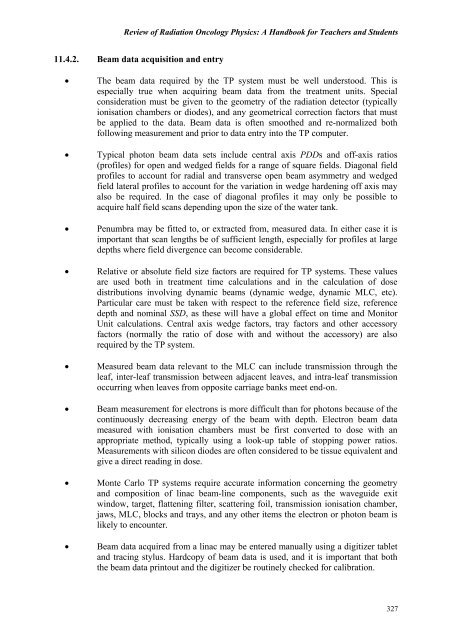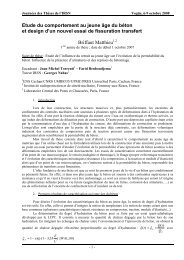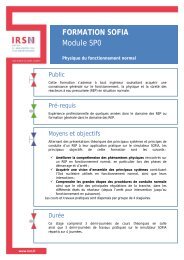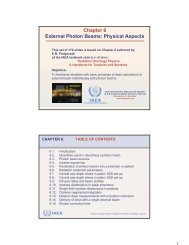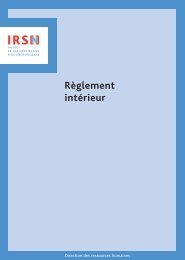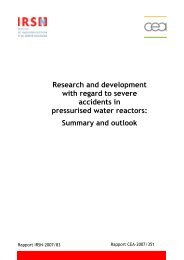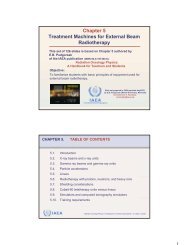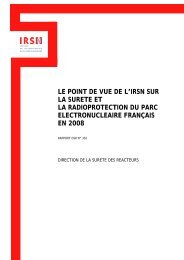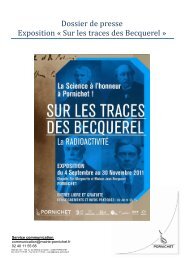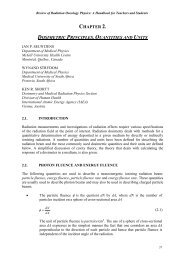Review of Radiation Therapy Physics: A syllabus for teachers ... - IRSN
Review of Radiation Therapy Physics: A syllabus for teachers ... - IRSN
Review of Radiation Therapy Physics: A syllabus for teachers ... - IRSN
Create successful ePaper yourself
Turn your PDF publications into a flip-book with our unique Google optimized e-Paper software.
<strong>Review</strong> <strong>of</strong> <strong>Radiation</strong> Oncology <strong>Physics</strong>: A Handbook <strong>for</strong> Teachers and Students11.4.2. Beam data acquisition and entry• The beam data required by the TP system must be well understood. This isespecially true when acquiring beam data from the treatment units. Specialconsideration must be given to the geometry <strong>of</strong> the radiation detector (typicallyionisation chambers or diodes), and any geometrical correction factors that mustbe applied to the data. Beam data is <strong>of</strong>ten smoothed and re-normalized bothfollowing measurement and prior to data entry into the TP computer.• Typical photon beam data sets include central axis PDDs and <strong>of</strong>f-axis ratios(pr<strong>of</strong>iles) <strong>for</strong> open and wedged fields <strong>for</strong> a range <strong>of</strong> square fields. Diagonal fieldpr<strong>of</strong>iles to account <strong>for</strong> radial and transverse open beam asymmetry and wedgedfield lateral pr<strong>of</strong>iles to account <strong>for</strong> the variation in wedge hardening <strong>of</strong>f axis mayalso be required. In the case <strong>of</strong> diagonal pr<strong>of</strong>iles it may only be possible toacquire half field scans depending upon the size <strong>of</strong> the water tank.• Penumbra may be fitted to, or extracted from, measured data. In either case it isimportant that scan lengths be <strong>of</strong> sufficient length, especially <strong>for</strong> pr<strong>of</strong>iles at largedepths where field divergence can become considerable.• Relative or absolute field size factors are required <strong>for</strong> TP systems. These valuesare used both in treatment time calculations and in the calculation <strong>of</strong> dosedistributions involving dynamic beams (dynamic wedge, dynamic MLC, etc).Particular care must be taken with respect to the reference field size, referencedepth and nominal SSD, as these will have a global effect on time and MonitorUnit calculations. Central axis wedge factors, tray factors and other accessoryfactors (normally the ratio <strong>of</strong> dose with and without the accessory) are alsorequired by the TP system.• Measured beam data relevant to the MLC can include transmission through theleaf, inter-leaf transmission between adjacent leaves, and intra-leaf transmissionoccurring when leaves from opposite carriage banks meet end-on.• Beam measurement <strong>for</strong> electrons is more difficult than <strong>for</strong> photons because <strong>of</strong> thecontinuously decreasing energy <strong>of</strong> the beam with depth. Electron beam datameasured with ionisation chambers must be first converted to dose with anappropriate method, typically using a look-up table <strong>of</strong> stopping power ratios.Measurements with silicon diodes are <strong>of</strong>ten considered to be tissue equivalent andgive a direct reading in dose.• Monte Carlo TP systems require accurate in<strong>for</strong>mation concerning the geometryand composition <strong>of</strong> linac beam-line components, such as the waveguide exitwindow, target, flattening filter, scattering foil, transmission ionisation chamber,jaws, MLC, blocks and trays, and any other items the electron or photon beam islikely to encounter.• Beam data acquired from a linac may be entered manually using a digitizer tabletand tracing stylus. Hardcopy <strong>of</strong> beam data is used, and it is important that boththe beam data printout and the digitizer be routinely checked <strong>for</strong> calibration.327


